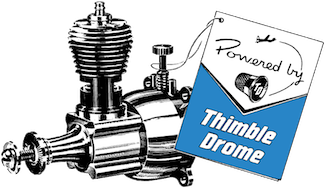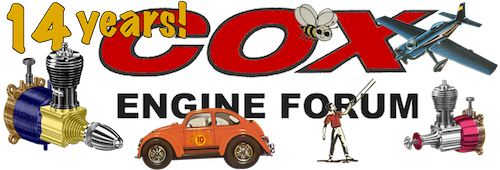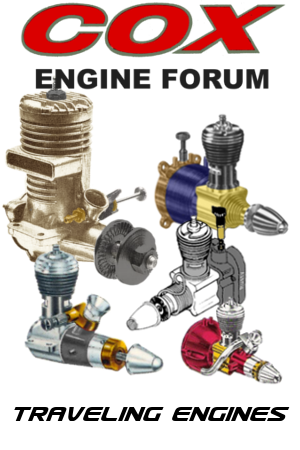Log in
Search
Latest topics
» Roger Harris revisitedby TD ABUSER Today at 2:30 am
» My latest doodle...
by batjac Yesterday at 10:05 pm
» Retail price mark-up.. how much is enough?
by gkamysz Yesterday at 9:29 pm
» Happy 77th birthday Andrew!
by roddie Yesterday at 9:22 pm
» My N-1R build log
by GallopingGhostler Yesterday at 3:04 pm
» Tee Dee .020 combat model
by 1/2A Nut Yesterday at 2:43 pm
» Chocolate chip cookie dough.........
by roddie Yesterday at 1:13 pm
» Purchased the last of any bult engines from Ken Enya
by sosam117 Yesterday at 11:32 am
» Free Flight Radio Assist
by rdw777 Yesterday at 9:24 am
» Funny what you find when you go looking
by rsv1cox Wed Nov 20, 2024 3:21 pm
» Landing-gear tips
by 1975 control line guy Wed Nov 20, 2024 8:17 am
» Cox NaBOO - Just in time for Halloween
by rsv1cox Tue Nov 19, 2024 6:35 pm
Cox Engine of The Month
an interesting waste of time
Page 1 of 2
Page 1 of 2 • 1, 2 
 an interesting waste of time
an interesting waste of time
I was just ruminating over Kim's picture of the big and little PT-19s and wondered what it would fly like if you shrink wrapped a layer of Ultracote over the wing. Except for the sharp LE, which could be rounded with a piece of balsa for almost no weight, it's shaped like an airfoil. A flat bottomed one, albeit, but still... 
It may not need 25 feet to take off any more.
No comments required, just my idle ramblings.

It may not need 25 feet to take off any more.
No comments required, just my idle ramblings.

_________________
Don't Panic!
...and never Ever think about how good you are at something...
while you're doing it!
My Hot Rock & Blues Playlist
...and never Ever think about how good you are at something...
while you're doing it!
My Hot Rock & Blues Playlist

RknRusty- Rest In Peace

- Posts : 10869
Join date : 2011-08-10
Age : 68
Location : South Carolina, USA
 Re: an interesting waste of time
Re: an interesting waste of time
It already has anundercambered airfoil (more lift but also more drag IIRC) of sorts

Cz10- Gold Member

- Posts : 229
Join date : 2011-08-17
 Re: an interesting waste of time
Re: an interesting waste of time
Or one could build one with a built up balsa wing and place it on the plane
In question.
In question.
 Re: an interesting waste of time
Re: an interesting waste of time
You might consider making some stationary flaps with strips of hard balsa and book tape. Start with just a slight deflection, then increase in gentle increments. Something I've thought about, but never seems to occur to me when I'm out in the shop. It's be interesting to see the results.

Kim- Top Poster




Posts : 8625
Join date : 2011-09-06
Location : South East Missouri
 Re: an interesting waste of time
Re: an interesting waste of time
I've considered that since mine are so warped from sitting in the hot car. It still flies, but could be better. I lost an auction for a pair of used wings once, but haven't found any more. It would be a lot lighter with a real balsa wing.nitroairplane wrote:Or one could build one with a built up balsa wing and place it on the plane
In question.
_________________
Don't Panic!
...and never Ever think about how good you are at something...
while you're doing it!
My Hot Rock & Blues Playlist
...and never Ever think about how good you are at something...
while you're doing it!
My Hot Rock & Blues Playlist

RknRusty- Rest In Peace

- Posts : 10869
Join date : 2011-08-10
Age : 68
Location : South Carolina, USA
 Re: an interesting waste of time
Re: an interesting waste of time
Thought several times of recreating the whole plane in balsa...never got to it.
It has great lines, just limited by the wing loading.
George
It has great lines, just limited by the wing loading.
George

gcb- Platinum Member

- Posts : 908
Join date : 2011-08-11
Location : Port Ewen, NY
 Re: an interesting waste of time
Re: an interesting waste of time
rusty:
It's from such ruminations that great ideas are born.
One of history's greastest "ruminations" was Leonard daVicini. In the 15th century he conceptualized and built working models that lead to great things. In aviation alone, he pioneered not only flight but means to achieve it like the "autogiro" based on a revovling air-screw which, in time, became the helicopter. Sikorsy may have "invented" but daVinci first visualized it.
Ruminate on Rusty!
SD
It's from such ruminations that great ideas are born.
One of history's greastest "ruminations" was Leonard daVicini. In the 15th century he conceptualized and built working models that lead to great things. In aviation alone, he pioneered not only flight but means to achieve it like the "autogiro" based on a revovling air-screw which, in time, became the helicopter. Sikorsy may have "invented" but daVinci first visualized it.
Ruminate on Rusty!
SD

SuperDave- Rest In Peace

- Posts : 3552
Join date : 2011-08-13
Location : Washington (state)
 Re: an interesting waste of time
Re: an interesting waste of time
Ig I remember rightly da Vinci also built the first object recognisable as a battle tank it even had holes for cannons and I think a rotating turret.
 Re: an interesting waste of time
Re: an interesting waste of time
nitro:
Yes, daVinci was in inovator in; flight, warfare, art,hydraulics, mechanics and agriculture with his his achievements too numerous to list here.
I once visited touring daVinci exhibit at the Museun of Flight in Seattle in '07 and was once again reading the brochure I received there.
It is said that Leonado loved to bedevil contemporary fellow artist Michel Angelo.
Leonardo's unbridled imagination and curiosity changed tthe world for all time and modern innovators often "stand on his shoulders".
SD
Yes, daVinci was in inovator in; flight, warfare, art,hydraulics, mechanics and agriculture with his his achievements too numerous to list here.
I once visited touring daVinci exhibit at the Museun of Flight in Seattle in '07 and was once again reading the brochure I received there.
It is said that Leonado loved to bedevil contemporary fellow artist Michel Angelo.
Leonardo's unbridled imagination and curiosity changed tthe world for all time and modern innovators often "stand on his shoulders".
SD

SuperDave- Rest In Peace

- Posts : 3552
Join date : 2011-08-13
Location : Washington (state)
 Re: an interesting waste of time
Re: an interesting waste of time
and back to the original topic...
yeah, i've thought about wrapping mine in monokote, which is the shrink covering materila miniglowplanes sells, but
i've decided to go with dope, just because it gives you an even surface without overlapping pieces of shrink foil.
yeah, i've thought about wrapping mine in monokote, which is the shrink covering materila miniglowplanes sells, but
i've decided to go with dope, just because it gives you an even surface without overlapping pieces of shrink foil.

GermanBeez- Platinum Member

- Posts : 1167
Join date : 2011-06-15
Location : Bavaria, Germany
 Re: an interesting waste of time
Re: an interesting waste of time
GermanBeez wrote:..... but I've decided to go with dope, just because it gives you an even surface without overlapping pieces of shrink foil.
Don't forget that nitrate is not fuel resistant; you can do a complete covering job with butyrate alone. If the plane is mostly open area, you can use high shrink dope, but be careful with the sheet components. The high shrink can curl these if you dope only one side at a time.
If you're brushing, you can sometimes get by with 1/3 thinner, 2/3 dope; spraying generally requires a 50/50 ratio as posted by nitroairplane. However, some of the high density colors may need more thinner when brushing, depending on vendor.
Lightweight silkspan will work nicely on this size plane. If you need to overlap silkspan, you can avoid a ridge by tearing the silkspan rather than cutting with scissors. Tearing will give you a feathered edge, since it is a fibrous material, that will blend in almost seamlessly. The same holds true for patching those punctures that always seem to appear -- tear the edges of the patch and after doping, it will be nearly invisible.
andrew
 Re: an interesting waste of time
Re: an interesting waste of time
I think he is building an all sheet pt19 I think he may only use dope not silk.
To fuelproof and then paint over it.
To fuelproof and then paint over it.
 Re: an interesting waste of time
Re: an interesting waste of time
nitroairplane wrote:I think he is building an all sheet pt19 I think he may only use dope not silk.
To fuelproof and then paint over it.
Ah ha! I can't keep the Lil Satan build separate from the PT-19. I suppose I can blame it on old age! Wait a minute, I can blame it on old age.
Then, he probably needs to select a low-shrink dope. Years ago, I ruined a little scratch built biplane when I used standard shrink dope on the 3/32" sides. It was SIG's Diana Cream and it bowed the sides so badly that the fuselage was completely unusable. I was heartbroken when I saw the results -- but, lesson learned the hard way.
andrew
 Re: an interesting waste of time
Re: an interesting waste of time
Andrew:
"Wisdom born of pain", don't we all know it? It seems "standard equipment as one acquires experience.
SD
"Wisdom born of pain", don't we all know it? It seems "standard equipment as one acquires experience.
SD

SuperDave- Rest In Peace

- Posts : 3552
Join date : 2011-08-13
Location : Washington (state)
 Re: an interesting waste of time
Re: an interesting waste of time
SuperDave wrote:Andrew:
"Wisdom born of pain", don't we all know it? It seems "standard equipment as one acquires experience.
SD
Yeah,
Running a .010 as a diesel.
Well I won't do it again with a stock crank.
 Re: an interesting waste of time
Re: an interesting waste of time
ok, im confused now. on the one hand its called fuel resistant dope, and on the other hand you say its not...andrew wrote:GermanBeez wrote:..... but I've decided to go with dope, just because it gives you an even surface without overlapping pieces of shrink foil.
Don't forget that nitrate is not fuel resistant; you can do a complete covering job with butyrate alone. If the plane is mostly open area, you can use high shrink dope, but be careful with the sheet components. The high shrink can curl these if you dope only one side at a time.
If you're brushing, you can sometimes get by with 1/3 thinner, 2/3 dope; spraying generally requires a 50/50 ratio as posted by nitroairplane. However, some of the high density colors may need more thinner when brushing, depending on vendor.
Lightweight silkspan will work nicely on this size plane. If you need to overlap silkspan, you can avoid a ridge by tearing the silkspan rather than cutting with scissors. Tearing will give you a feathered edge, since it is a fibrous material, that will blend in almost seamlessly. The same holds true for patching those punctures that always seem to appear -- tear the edges of the patch and after doping, it will be nearly invisible.
andrew
i will brush it on, just because i dont have an air brush. (takes up too much space)

GermanBeez- Platinum Member

- Posts : 1167
Join date : 2011-06-15
Location : Bavaria, Germany
 Re: an interesting waste of time
Re: an interesting waste of time
It is methanol
And oil proof but not nitromethane proof so if you use higher than 20% it will start to soak through.
And oil proof but not nitromethane proof so if you use higher than 20% it will start to soak through.
 Re: an interesting waste of time
Re: an interesting waste of time
well, i run 12, so i wont have to care.nitroairplane wrote:It is methanol
And oil proof but not nitromethane proof so if you use higher than 20% it will start to soak through.

GermanBeez- Platinum Member

- Posts : 1167
Join date : 2011-06-15
Location : Bavaria, Germany
 Re: an interesting waste of time
Re: an interesting waste of time
Ok it will still eat through but not as much you shoul do 3 or 4 coats of 70% dope 30% thinner I reccomend using cellulose not butyrate as cellulose is more fuel proof.
 Re: an interesting waste of time
Re: an interesting waste of time
GermanBeez wrote:ok, im confused now. on the one hand its called fuel resistant dope, and on the other hand you say its not...
i will brush it on, just because i dont have an air brush. (takes up too much space)
GB ---
Dope comes in two formulations: Nitrate and butyrate (these are both cellulose derivatives, but came about later than the original cellulose acetate) Each formulation can be found in tautening (high-shrink) and non-tautening (low-shrink) forms.
Years ago, many of us used both nitrate and butyrate dope when finishing a model. Initial preparation of the airframe and application of the covering was usually done with nitrate dope. Nitrate has slightly better adhesion qualities than butyrate and was the choice to prep raw wood and stick the covering down. Many times, nitrate was also used for doping the covering over open areas such as built up wings, stabs, rudders and stick fuselages. We tended to build much more open structures than we do today. However, nitrate dope has two qualities that restrict its usage: Nitrate dope cannot be applied over butyrate, but butyrate can be applied over nitrate. Secondly, nitrate is affected by glowfuel and will deteriorate when exposed to nitromethane; butyrate is sometimes classed as fuelproof, although in reality, it is really fuel resistant. Butyrate does well with glowfuel, but prolonged exposure to high nitro fuels can cause problems. Rather than keep both formulations on hand, I tend to use butyrate only since it is quite adequate for adhering covering and can be used as the final topcoat.
Both nitrate and butyrate dope will continue to shrink over the lifetime of the covering, but most of the shrinkage will occur during the first 72 or so hours as the volatiles gas off. Tautening dope is generally applied to covering stretched on open areas – this ensures that the covering will tighten up and remain tight. The norm is not to use high-shrink dope on sheeted surfaces because it can cause the sheet to curl toward the doped side – in some cases, it can twist the structure complete out of shape. This was the situation I ran into with my biplane and ended up tossing the fuselage. For some lightly built stick and tissue models, even the use of high-shrink dope on the tissue alone can apply enough stress to warp the structure. Consequently, use the non-tautening (low-shrink) variety on most, if not all, sheeted areas.
Early on, companies only supplied high-shrink dope and we had to add a plasticizer to reduce shrinkage. There was a commercial product, but old timers just added a drop of castor oil to an ounce or so of dope to achieve the same effect.
Beautiful finishes can be created using dope, but the time involved can actually be longer than that required to build the plane. There are a number of old timers on the forum that likely grew up using dope and tissue or dope and silk and they may very well have better advice on the matter.
andrew
 Re: an interesting waste of time
Re: an interesting waste of time
thanks so much!
so it's butyrate, then. i'm sure i'll find some in my local hobby store. they usually have a lot of different paints.
so it's butyrate, then. i'm sure i'll find some in my local hobby store. they usually have a lot of different paints.

GermanBeez- Platinum Member

- Posts : 1167
Join date : 2011-06-15
Location : Bavaria, Germany
 Re: an interesting waste of time
Re: an interesting waste of time
More stuff --
Surface prep: Unless a little care is taken, doping raw wood can add more weight than one might expect. Since balsa is so porous, it will soak up a lot of dope. Sand well before doing anything. I like to paint on a thinned light coat of clear first; this will help seal the pores and reduce the amount of dope needed on later coats. It will also raise the grain and leave the surface feeling like sandpaper -- this is easily sanded off. I don't try to wipe the sanding dust away from the first coat, just off the surface so it fills in some of the open grain. We used to add talcum powder to clear dope to help fill the grain, but talcum powder is heavy and there are commercial sanding sealers that have lightweight fillers added - this should be low-shrink butyrate. Both SIG and Brodak carry sealers, so you can read about them on their sites. Unless you get the surface filled, the color coats will look rough. The process is simple: fill, sand, fill, sand, fill, sand, ..... The idea is to paint on the sealer/filler, then sand back to the top surface of the wood, leaving filler only in the pores. Eventually, these pores will fill in level with the top surface -- no sealer should be seen on the actual top surface. You need to be careful when sanding so that you don't cut into the top surface, just remove the filler. Using a sealer/filler to prep the surface is usually better than trying to fill with colored dope since the filler generally is lighter than the color pigments. If the wood is real open grained, I have doped on lightweight silkspan and prepped it instead. This prep can be really time consuming, but the final product is dependent on how smooth the surface is. If the plane is going to be a beater, I don't invest a lot of time and effort. A completely prepared surface will look and feel like glass, but each coat adds a little weight and if you're not competing on finish, it is not necessary.
Since you're brushing, thinning the top coats with 40% to 50% thinner will help it flow and allow the brush marks to flatten before the dope skins over. Color coats also may be sanded, but sanding will cut the gloss. A final light coat of thinned clear will restore the brightness.
Blushing: If you paint/spray in high humidity, the dope may blush or develop whitish areas. This is due to moisture being trapped in he actual dope. The volatiles gas off before the moisture evaporates and the surface skins over, trapping the moisture. This can usually be removed by spraying or painting with thinner -- dope has an unsual property that it will dissolve when thinner is used. Blush should only be treated on a very dry day to help disperse the water before skinning again. The advantage is that a top coat will dissolve the underlying coat and the bond is very strong.
Orange peel: Surface coat looks pitted, like the surface of an orange. Usually caused by the coat being too thick, the dope surface hardens before all the volatiles gas off. As the solvents continue to evaporate, you end with microscopic pits in the topcoat. Thin light coats are not as prone to orange peel effects.
Fisheyes: Only really a problem when competing on finish quality. If you put a drop of oil in a water puddle, you get concentric rings of color spreading across the surface. Fisheyes are caused by surface contamination, usually water, oil or silicon. The dope pulls away from the point of contamination, leaving the appearance of a fisheye because it will not "stick" where the contamination occurs.
Bridging: Generally only a problem with high-shrink dope applied on solid surfaces. In areas where joints occur, such as where the stab meets the fuselage, dope may bridge. If the dope is high-shrink or put on too thick at the 90 degree joint, as it cures and shrinks, it can actually pull away from the joint forming a bridge between the side of the fuselage and stab. It gives the appearance of a fillet, but it is only dope with an open area underneath. After setting up, if you run a piece of wood along this bridge, the dope will crack away leaving raw wood underneath. Sand away, flatten with thinner and re-apply; otherwise it will serve as an opening for oil incursion. This is one of the worst places because most bridging will occur at glue joints.
Whew -- enough rambling. Some of you other guys help me out and add your comments or fix my errors.
andrew
Surface prep: Unless a little care is taken, doping raw wood can add more weight than one might expect. Since balsa is so porous, it will soak up a lot of dope. Sand well before doing anything. I like to paint on a thinned light coat of clear first; this will help seal the pores and reduce the amount of dope needed on later coats. It will also raise the grain and leave the surface feeling like sandpaper -- this is easily sanded off. I don't try to wipe the sanding dust away from the first coat, just off the surface so it fills in some of the open grain. We used to add talcum powder to clear dope to help fill the grain, but talcum powder is heavy and there are commercial sanding sealers that have lightweight fillers added - this should be low-shrink butyrate. Both SIG and Brodak carry sealers, so you can read about them on their sites. Unless you get the surface filled, the color coats will look rough. The process is simple: fill, sand, fill, sand, fill, sand, ..... The idea is to paint on the sealer/filler, then sand back to the top surface of the wood, leaving filler only in the pores. Eventually, these pores will fill in level with the top surface -- no sealer should be seen on the actual top surface. You need to be careful when sanding so that you don't cut into the top surface, just remove the filler. Using a sealer/filler to prep the surface is usually better than trying to fill with colored dope since the filler generally is lighter than the color pigments. If the wood is real open grained, I have doped on lightweight silkspan and prepped it instead. This prep can be really time consuming, but the final product is dependent on how smooth the surface is. If the plane is going to be a beater, I don't invest a lot of time and effort. A completely prepared surface will look and feel like glass, but each coat adds a little weight and if you're not competing on finish, it is not necessary.
Since you're brushing, thinning the top coats with 40% to 50% thinner will help it flow and allow the brush marks to flatten before the dope skins over. Color coats also may be sanded, but sanding will cut the gloss. A final light coat of thinned clear will restore the brightness.
Blushing: If you paint/spray in high humidity, the dope may blush or develop whitish areas. This is due to moisture being trapped in he actual dope. The volatiles gas off before the moisture evaporates and the surface skins over, trapping the moisture. This can usually be removed by spraying or painting with thinner -- dope has an unsual property that it will dissolve when thinner is used. Blush should only be treated on a very dry day to help disperse the water before skinning again. The advantage is that a top coat will dissolve the underlying coat and the bond is very strong.
Orange peel: Surface coat looks pitted, like the surface of an orange. Usually caused by the coat being too thick, the dope surface hardens before all the volatiles gas off. As the solvents continue to evaporate, you end with microscopic pits in the topcoat. Thin light coats are not as prone to orange peel effects.
Fisheyes: Only really a problem when competing on finish quality. If you put a drop of oil in a water puddle, you get concentric rings of color spreading across the surface. Fisheyes are caused by surface contamination, usually water, oil or silicon. The dope pulls away from the point of contamination, leaving the appearance of a fisheye because it will not "stick" where the contamination occurs.
Bridging: Generally only a problem with high-shrink dope applied on solid surfaces. In areas where joints occur, such as where the stab meets the fuselage, dope may bridge. If the dope is high-shrink or put on too thick at the 90 degree joint, as it cures and shrinks, it can actually pull away from the joint forming a bridge between the side of the fuselage and stab. It gives the appearance of a fillet, but it is only dope with an open area underneath. After setting up, if you run a piece of wood along this bridge, the dope will crack away leaving raw wood underneath. Sand away, flatten with thinner and re-apply; otherwise it will serve as an opening for oil incursion. This is one of the worst places because most bridging will occur at glue joints.
Whew -- enough rambling. Some of you other guys help me out and add your comments or fix my errors.
andrew
 Re: an interesting waste of time
Re: an interesting waste of time
you know, this seems like a LOT of work to invest in one's first plane...i don't
want to sand and paint for a week just to break it somehow the next day. then all my work has gone to bits...
putting monokote on just seems to be the quicker and easier solution.
want to sand and paint for a week just to break it somehow the next day. then all my work has gone to bits...
putting monokote on just seems to be the quicker and easier solution.

GermanBeez- Platinum Member

- Posts : 1167
Join date : 2011-06-15
Location : Bavaria, Germany
 Re: an interesting waste of time
Re: an interesting waste of time
GermanBeez wrote:you know, this seems like a LOT of work to invest in one's first plane...i don't
want to sand and paint for a week just to break it somehow the next day.
GB --
Don't get discouraged, much of the above was just informational.
For a first attempt, just get enough dope on to keep the oil out; it's not at all necessary to expend either a lot of time or effort to get a flyable model. For 1/2A planes that I knew were going to take a beating (when my son was learning to fly), I just used spray cans from the hardware store. Spent a total of 8 to 10 minutes for all the coats necessary.
Page 1 of 2 • 1, 2 
 Similar topics
Similar topics» Is it just me....spam/scam/BS...and just plain waste of time
» Interesting
» Whats in your fuel closet/shelf/bunker?
» Now this is interesting... or heresy.
» Flew yesterday, first time in a LONG time....
» Interesting
» Whats in your fuel closet/shelf/bunker?
» Now this is interesting... or heresy.
» Flew yesterday, first time in a LONG time....
Page 1 of 2
Permissions in this forum:
You cannot reply to topics in this forum

 Rules
Rules







